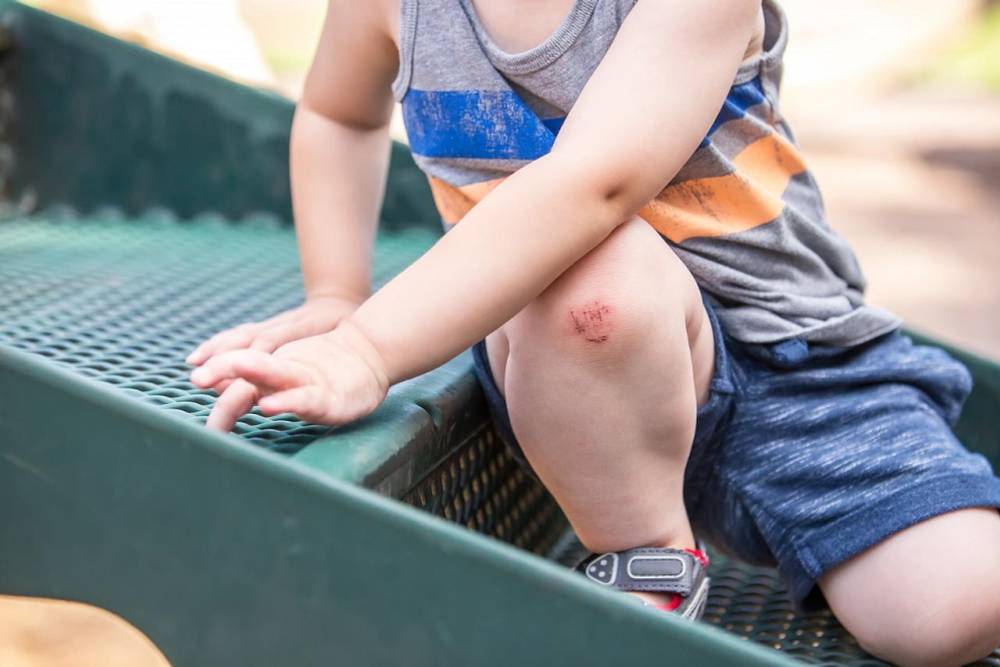Abrasions on the knees, minor burns, bumps on the head, or insect bites. You all know these awkward situations well. Although you tell your child all the time not to run, he “catches a hare” from time to time. Abrasions are the most common trauma we encounter in young children. How to properly treat abrasions, scrapes or cuts?
Care for minor injuries and abrasions
Abrasions and minor cuts
Thoroughly rinse the abrasion and surrounding area with clean water. If the wound is bleeding, apply gauze or a clean handkerchief to the affected area. Then disinfect the wound to prevent infection. Non-flammable disinfectants are more suitable for children.
An alternative are creams or gels that have both disinfecting and healing effects. Finally, apply the hydrocolloid patch to the baby’s wound. It also adheres well to the knee or elbow and is designed to be left on the affected area for a longer period of time. Removing it after a few days will not harm the baby because he will no longer tear the newly formed tissue. If an injury requires it, fix the affected area with a sterile bandage.
If you are unable to stop the bleeding, the area around the wound is still red and swollen as it heals, or the wound starts to secrete pus or hurts badly, or if the temperature rises, see your child and baby.
Minor burns
Unfortunately, children find themselves in a number of situations in which they can get burned. This can be hot water, fire burns, or severe friction burns. How to deal with it?
First, treatment consists of cooling the affected area with cold water. After cooling, it is again advisable to disinfect the affected area or apply local sedative and healing preparations. Instead of the classic coating, it is also more advisable to use a hydrocolloid patch or other special coating designed for burns, which keeps the burn in a moist environment, thereby supporting and accelerating the formation of new skin cells. They also relieve pain and reduce the risk of scarring. However, for severe burns or burns to the head and neck, you should always see a doctor.
Bumps on the head and pinched fingers
You might think that young children should wear a helmet and hand protectors while having fun. Headaches are common in many families. How can you help a little anxiety in this case?
If the child bumps his head and jumps or accidentally pinches his fingers, quickly apply a cool compress to the affected area. For example, ice cubes wrapped in a towel will help. A cold compress will slightly relieve pain and prevent swelling. However, if the bulging head hurts badly, see your child’s doctor.
Insect bites
Insect bites are very unpleasant for young children, be they mosquitoes, flycatchers, wasps or bees. Caution should be exercised, especially in the case of wasp or bee stings, due to the risk of an unexpected allergic reaction. How to act and what to pay attention to?
Care for minor injuries and abrasions 2
Instead of being bitten, it is advisable to calm down with an ice pack. This will reduce the swelling and numb the injury a little. In the event of a bee sting, remove the sting with tweezers as soon as possible. Instead of bites, then treat with an itch-relieving and allergic reaction-reducing agent. Watch your baby for a possible allergic reaction for the next few minutes. In case of unexpected difficulty in breathing, seek immediate medical attention. Protect children from insect bites with suitable clothing and repellents.
Minor injuries sometimes affect every young child. If you get bruised or pinched, keep your cool and don’t panic. Children will be calmer and, in the end, will not pay as much attention to their injuries as when they feel their parents’ nervousness.

Leave a Reply